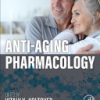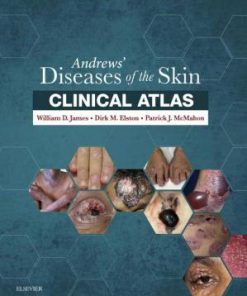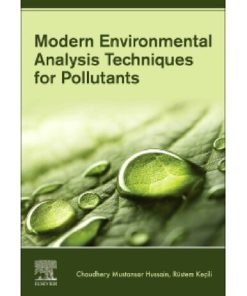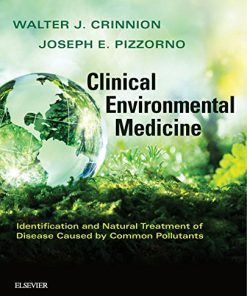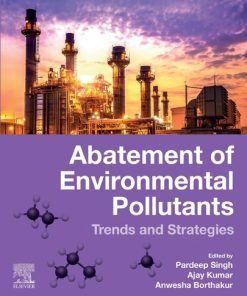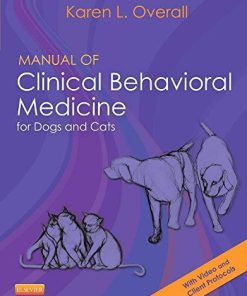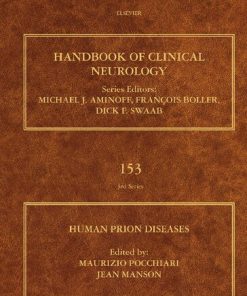(Ebook PDF) Clinical Environmental Medicine: Identification and Natural Treatment of Diseases Caused by Common Pollutants 1st Edition by Walter Crinnion, Joseph Pizzorno ISBN 9780323480857 0323480853 full chapters
$50.00 Original price was: $50.00.$25.00Current price is: $25.00.
(Ebook PDF) Clinical Environmental Medicine: Identification and Natural Treatment of Diseases Caused by Common Pollutants 1st Edition by Walter Crinnion, Joseph Pizzorno-Ebook PDF Instant Download/Delivery:9780323480857, 0323480853
Instant download Full Chapter of after payment
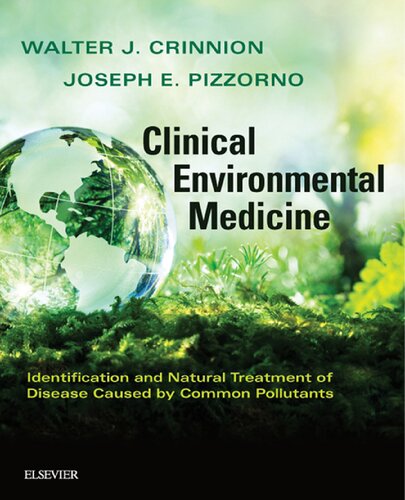
Product details:
ISBN 10: 0323480853
ISBN 13: 9780323480857
Author: Walter J. Crinnion; Joseph E. Pizzorno
Did you know that high levels of toxins in the human body can be linked to common conditions such as infertility, obesity, rheumatoid arthritis, heart disease, and diabetes? With therapeutic guidance designed for clinicians, Clinical Environmental Medicine focuses on how toxins such as arsenic, lead, mercury and organophosphates have become one of the leading causes of chronic disease in the industrial world. The first edition of this text describes how to treat these undesirable elements and molecules that can poison enzyme systems, damage DNA, increase inflammation and oxidative stress, and damage cell membranes. Expert authors Walter Crinnion and Joseph E. Pizzorno offer practical guidance for assessing both total body load as well as specific toxins. In addition, evidence-based treatment procedures provide recommendations for decreasing toxin exposure and supporting the body’s biotransformation and excretion processes.
Table of contents:
- Section I Introduction to Environmental Medicine
- 1 The Science of Environmental Medicine
- Environmental Health Professions
- Total Toxicant Body Burden
- Other Factors Important in Environmental Medicine
- References
- 2 Oxidative Damage and Inflammation
- Description
- Mechanisms
- Sources
- Assessment
- Biotransformation and Oxidative Stress
- Clinical Significance
- Intervention
- References
- 3 Food Pollution
- Introduction
- Persistent Organic Pollutants
- Nonpersistent Pollutants
- Intervention
- Organic Foods
- References
- 4 Water Pollution
- Introduction
- Major Pollutants and Adverse Health Effects
- Intervention
- References
- 5 Indoor Air Pollution
- Overview
- Solvents
- Intervention
- References
- 6 Outdoor Air Pollution
- Overview
- Major Pollutants
- Adverse Health Effects
- References
- 7 Health and Beauty Products
- Description
- Sources
- Body Burden
- Intervention
- References
- 8 Drugs
- Description
- Toxicity
- Clinical Significance
- Detoxification/Excretion Processes
- Intervention
- References
- Section II The Toxicants
- Metals
- 9 Arsenic
- Description and Toxicity
- Sources
- Intervention
- References
- 10 Cadmium
- Sources
- Body Burden
- Intervention
- References
- 11 Hexavalent Chromium
- Description
- Toxicity
- Sources
- Body Burden
- Intervention
- References
- 12 Cobalt
- Description
- Toxicity
- Sources
- Body Load
- Intervention
- References
- 13 Lead
- Description
- Toxicity/Metabolism
- Sources
- Body Burden
- Intervention
- References
- 14 Mercury
- Description
- Toxicity
- Sources
- Body Burden
- Assessing Biomarkers
- Treatment
- References
- 15 Other Metals
- Description
- Toxicity
- Sources
- Body Burden and Assessment
- Detoxification/Excretion Processes
- Clinical Significance
- Intervention
- References
- Inorganic Chemicals
- 16 Fluoride
- Description
- Toxicity
- Sources
- Body Burden
- Intervention
- References
- Solvents
- 17 Benzene, Toluene, Ethylbenzene, Xylenes (BTEX)
- Description
- Toxicity
- Sources
- Body Burden
- Intervention
- References
- 18 Chlorinated Solvents
- Description
- Toxicity
- Sources
- Body Burden
- Intervention
- References
- 19 Styrene
- Description
- Toxicity
- Sources
- Body Burden
- Intervention
- References
- Pesticides
- 20 Organochlorine Pesticides
- Description
- Toxicity
- Sources
- Body Burden
- References
- 21 Organophosphate Pesticides
- Description
- Toxicity
- Sources
- Body Burden
- Intervention
- References
- 22 Pyrethroid Pesticides
- Description
- Toxicity
- Sources
- Body Burden
- Intervention
- References
- Herbicides
- 23 Glyphosate and Petroleum Distillates
- Description
- Toxicity
- Sources
- Body Burden
- Intervention
- References
- 24 Chlorophenoxy Herbicides
- Description
- Toxicity
- Sources
- Body Burden
- Intervention
- References
- Plasticizers
- 25 Bisphenol A
- Description
- Toxicity
- Sources
- Body Burden
- Intervention
- Bisphenol Analogs
- References
- 26 Phthalates
- Description
- Sources
- Body Burden
- Intervention
- References
- Other Persistants
- 27 Polybrominated Diphenyl Ethers
- Description
- Toxicity
- Sources
- Body Burden
- Intervention
- References
- 28 Polychlorinated Biphenyls
- Description
- Toxicity
- Sources
- Body Burden
- Intervention
- References
- 29 Perfluorocarbons
- Description
- Sources
- Body Burden
- Intervention
- References
- Preservatives
- 30 Parabens
- Description
- Toxicity
- Body Burden
- Detoxification/Excretion Processes
- Intervention
- References
- Airborne
- 31 Mold and Water-Damaged Building Toxicity
- Introduction
- Toxins Produced in Water-Damaged Buildings
- Health Effects
- Diagnosis/Assessment
- Intervention
- References
- 32 Ozone
- Description
- Toxicity
- Sources
- Assessment
- Intervention
- References
- 33 Particulate Matter and Polycyclic Aromatic Hydrocarbons
- Description
- Toxicity
- Sources
- Body Burden
- Intervention
- References
- 34 Sulfur and Nitrogen Oxides
- Description
- Toxicity
- Sources
- Body Burden
- Intervention
- References
- Endogenous
- 35 Endotoxicity
- Description
- Sources
- Toxicity
- Detoxification/Excretion Processes
- Clinical Significance
- Intervention
- References
- Toxins of Choice
- 36 Alcohol
- Description
- Toxicity
- Sources
- Body Burden
- Intervention
- References
- 37 Marijuana
- Description
- Toxicity
- Body Burden
- Intervention
- Benefits
- Conclusion
- References
- 38 High Fructose Corn Syrup
- Description
- Toxicity
- Sources
- Body Burden
- Intervention
- References
- 39 Salt
- Description
- Toxicity
- Sources
- Body Burden
- Intervention
- References
- 40 Smoking
- Description
- Toxicity
- Sources
- Body Burden
- Intervention
- References
- 41 Wheat
- Description
- Toxicity
- Sources
- Body Burden
- Intervention
- References
- Section III Systemic Effects of Toxins and Toxicants
- 42 Neurotoxicity
- Introduction
- Basic Mechanisms of Neurotoxicity
- Disease Manifestation
- Diseases
- Assessment
- Intervention
- References
- 43 Immunotoxicity
- Overview/Introduction
- Basic Mechanisms
- Disease Manifestation
- Assessment
- Intervention
- References
- 44 Endocrine Toxicity
- Introduction
- Disease Manifestation
- Assessment
- Intervention
- References
- 45 Mitochondrial Toxicity
- Overview
- Mitochondrial Insufficiency
- Assessment
- Intervention
- References
- 46 Respiratory Toxicity
- Description
- Basic Mechanisms of Toxicity
- Sources of Respiratory Toxicants
- Assessment
- Intervention
- References
- 47 Cardiovascular Toxicity
- Overview/Introduction
- Disease Manifestation
- Assessment
- Intervention
- References
- 48 Musculoskeletal Toxicity
- Description
- Basic Mechanisms of Toxicity
- Sources of Musculoskeletal Toxicants
- Assessment
- Intervention
- References
- 49 Liver Toxicity
- Description
- Toxicity—Mechanisms of Action
- Sources
- Assessment
- Intervention
- References
- 50 Renal Toxicity
- Introduction
- Kidney Excretion of Toxins and Toxicants
- How the Kidneys Are Damaged
- Protecting and Regenerating the Kidneys
- References
- 51 Cancer
- Description
- Clinical Significance—Cancer Sites and Associated Toxicants
- Additional Factors Associated With Cancer
- Body Burden
- Intervention
- References
- Section IV Assessment of Toxic Load
- 52 Assessment
- Identifying Environmental Illness
- Patient Examples
- The Diagnostic Opportunity Afforded by Chemical Sensitivity
- Classic Patterns
- References
- 53 Laboratory Assessment of Toxicant Levels
- Introduction
- Normalizing Results
- Prevention and Preconception Care
- Identification of Health-Damaging Pollutants
- Refereences
- 54 Conventional Laboratory Tests to Assess Toxic Load
- Assessment of Toxic Load
- Direct Measures of Toxicants
- Conventional Laboratory Tests
- References
- 55 8-Hydroxy-2′-deoxyguanosine and Other Nucleoside Metabolites
- Description
- Assessment of Urinary 8-OHdG
- Sources
- Clinical Significance
- Intervention
- References
- Section V Biotransformation and Excretion
- 56 Biotransformation and Elimination
- Functionalization (Phase 1)
- Conjugation (Phase 2)
- Routes of Excretion (Phase 3)
- Assessment
- References
- 57 Lung Excretion
- Introduction
- Function
- Analysis
- Specific Toxicants
- References
- 58 Hair Excretion
- Introduction
- Hair Mineral Analysis
- Excretion of Minerals and Metals
- Hair Status and Systemic Disease
- Excretion of NonElemental Toxins and Toxicants
- Autism: Analysis of Hair Testing Data With Pathophysiological Implications
- References
- 59 Breast Milk Excretion
- Introduction
- Synthesis and Composition of Breast Milk
- Analysis
- References
- Section VI Therapeutics
- 60 Avoidance
- Introduction
- Reducing Exposure to Air Pollutants
- References
- 61 Sauna
- Overview
- Sauna Types
- Physiological Response to Sauna Therapy
- Contraindications for Sauna Therapy
- References
- 62 Gastrointestinal and Renal Elimination
- Overview
- Reducing Hepatic and Renal Recycling (Reabsorption)
- References
- 63 Microbiome
- Overview
- Health Properties of Probiotics
- Endotoxemia
- Factors That Alter the Microbiome
- Specific Benefits
- Support
- References
- 64 Chelation (Oral and Intravenous)
- Description
- Chelating Agents
- Chelatable Toxicants
- References
- 65 Nutritional Supplementation for Environmental Toxins and Toxicants
- Overview
- Most Common Natural Antitoxicant Compounds
- Enhancement of Biotransformation and Excretion
- Amelioration of Specific Toxicant-Induced Damage
- References
- Appendix A Dimercaptosuccinic Acid Metal Mobilization Protocol: Two Days On and Five Days Off
- Appendix B Dimercaptosuccinic Acid Metal Mobilization Protocol: Five Days On and Nine Days Off
- Appendix C CaEDTA/DMPS IV Metal Mobilization Protocol
- Appendix D Intravenous Metal Mobilization Testing
- Appendix E Oral Metal Mobilization Testing
- Appendix F Environmental Exposure Questionnaire
- Environmental Toxic Exposure / Residence History
- Environmental Toxic Exposure / Occupational History
- Appendix G Environmental Exposure Questionnaire: Interpretation Guide
- A Metabolism of Pollutants:
- B Toxicant-Related Health Problems:
- C Pollutant Exposure:
People also search:
clinical environmental medicine pdf
clinical environmental medicine book
textbook of clinical occupational and environmental medicine
textbook of clinical occupational and environmental medicine pdf
environmental medicine doctor near me
Tags:
Clinical Environmental Medicine,Natural Treatment,Common Pollutants,Walter Crinnion,Joseph Pizzorno
You may also like…
Medicine - Dermatology
Science (General)
Politics & Philosophy - European & American Philosophy
Engineering
Abatement of Environmental Pollutants: Trends and Strategies 1st Edition Pardeep Singh (Editor)
Medicine & Health Science
Manual of Clinical Behavioral Medicine for Dogs and Cats 1st Edition
Medicine - Neurology
Handbook Of Clinical Neurology: Human Prion Diseases 1st Edition Maurizio Pocchiari
Business & Economics - Industries
Rare earths industry: technological, economic, and environmental implications 1st Edition


